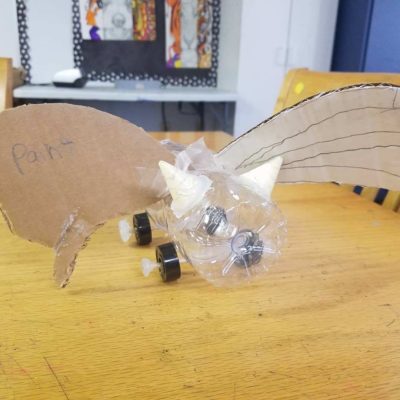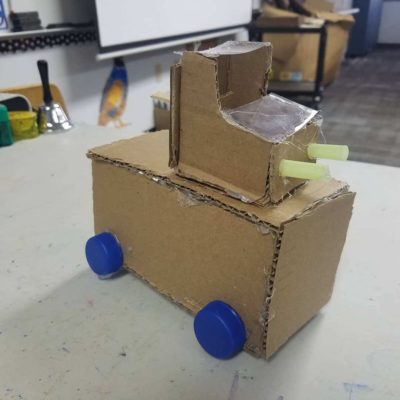PBL and Art Integration: How project-based learning in elementary schools affects art teachers
Estelle Hilmen is an art teacher at Capri Elementary in Encinitas, CA. Prior to working at Capri she taught at High Tech Elementary, where she gained her expertise in Project-based learning and art integration. I am a huge fan of Estelle’s work and am grateful that she took the time for me to pick her brain a bit about how project -based learning in elementary schools affects art teachers.
Jenny: What is your favorite project that you have done in your art class this year?
Estelle: Plains, Trains and Automobiles is a design project that uses the design principles that are used by many engineers today.
Jenny: How did you come up with the idea for this project?
Estelle: I really love to build and have projects that are open ended. I was looking for a project that would enable me to introduce design principles, use unconventional materials and allow my students to move around the classroom and think outside the box.
Jenny: What were some of the benefits to this project? What components of this project are you most proud of?
Estelle: There are many benefits to this project. A main benefit is that it makes students think outside the box and think three dimensionally. Students have to first come up with a design, look for materials, see if the materials will work and build. That’s a lot of preplanning, planning and execution! This is a dynamic project that is constantly evolving. I see students who are normally quiet or not interested in art come alive. This type of project calls to everyone. Students can work in pairs or alone. They are excited to show each other what they are building and that excitement leads to some amazing discussions and collaborations.
Jenny: What were some of the “deltas” to this project, if you were to do it again?
Estelle: My time with students is limited. I see my fourth graders every four weeks for four weeks. I wish I could incorporate writing and also math into this project.
Jenny: What did the classroom teachers do to show their support of your project? What was helpful or what could have enhanced the project even more?
Estelle: Classroom teachers are very supportive of this project. They sent out emails to families explaining the project and we were able to collect a lot of recyclables.
Jenny: How did you measure “success” of this project?
Estelle: Success depends on the build. Does it look like a plane, train or automobile? Are there doors or windows and how did they build those? Did they use materials in a creative way? While this may seem subjective, it is quite easy to see if students have put a lot of effort into their design or not.
Jenny: What did assessment look like for this project?
Estelle: Students receive a grade based on completion and effort. I observe throughout the cycle of the project. I look for the following:
- Are students engaged during build time?
- Are students trying to use different materials in unique ways?
- Are students collaborating, offering critique?
- Did students finish the project and use their time wisely?
Jenny: How does project based learning in elementary schools affect art teachers?
Estelle: I think that depends on the art teacher and whether classroom teachers want to collaborate. In my situation, that has not happened yet. However, an art or engineering teacher can help students dive deeper into a project and in many instances, make that project come alive. We are also better equipped at handling large scale projects that might need to be stored for several weeks. Not to mention the mess that comes with that. I think it takes a special teacher who can collaborate on projects because they have to be able to think outside the box and see the project from an artistic point of view and how that project could enhance PBL.
Jenny: What advice would you give to other art teachers who are thinking about PBL? Or teachers in general?
Estelle: Don’t be afraid to try something new. A project may not turn out quite like you wanted it to or it may present itself with unknown difficulties. Struggle is not a bad thing, it makes you more real in the eyes of your students. They see you struggle and realize that it’s ok. It’s how you handle that struggle. I always tell students, “It’s ok to think something is hard and to voice that outloud. It’s not ok not to try.” I think that’s a motto we can all stand by.
For more PBL and art resources you can contact Estelle at pralyhilmen@yahoo.com
or follow her student work on Instagram @caprielementary.


